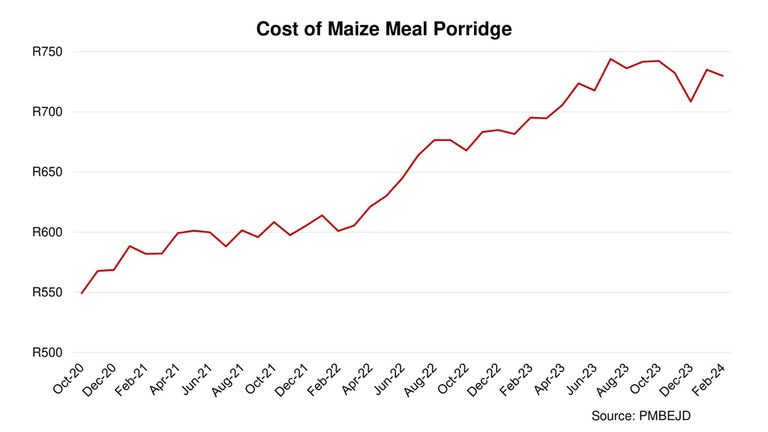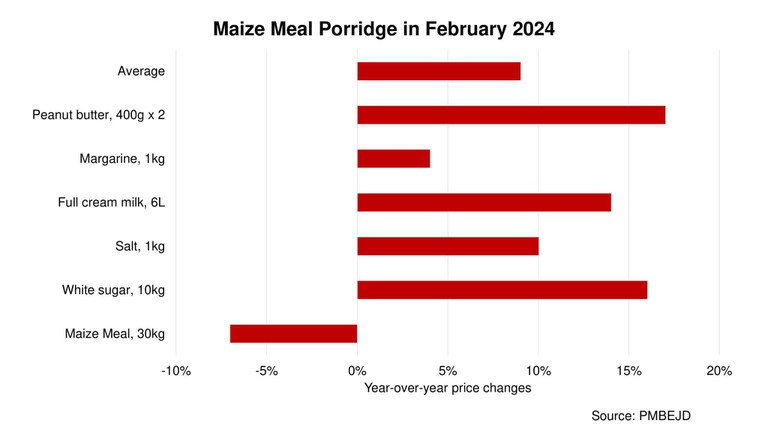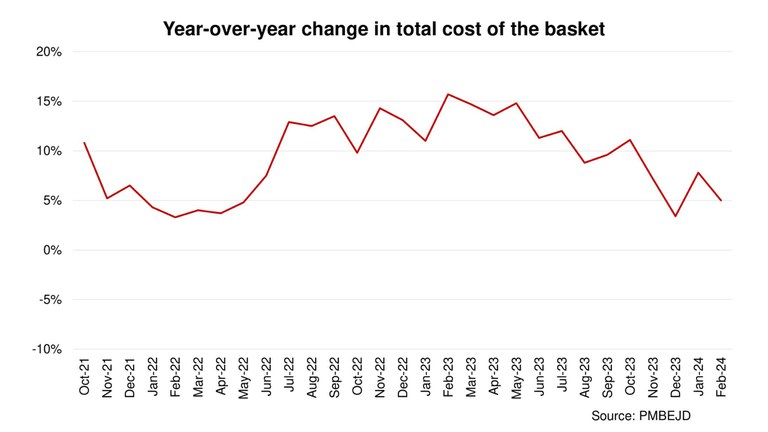![[Opinion] Maize Meal Porridge Index shows effect of food inflation on low-income households [Opinion] Maize Meal Porridge Index shows effect of food inflation on low-income households](https://cra-sa.com/media/maize-meal-porridge-index-shows-effect-of-food-inflation-on-low-income-households/@@images/a49eeead-25a2-4952-83ec-125af621fd91.jpeg)
A new index, the Maize Meal Porridge Index, has been created to show the effect of food inflation on low-income households and underscores the challenge posed by rising food costs compared to the relatively slower growth in wages, highlighting potential concerns about affordability, especially for low-income households.
Statistics South Africa’s latest Consumer Price Index (CPI) figures show that headline inflation increased to 5.3% in January from 5.1% in December after two consecutive months of decline. Food and non-alcoholic beverages were the main drivers of inflation, increasing by 7.2%.
Against this backdrop, the Centre For Risk Analysis developed the Maize Meal Porridge Index using data from the Pietermaritzburg Economic Justice and Dignity Household Food Basket to determine the impact of food inflation on low-income households, Mlondi Mdluli, senior economic researcher at the centre, says.
The Household Food Basket contains specific foods and quantities that women from an average low-income household, typically consisting of seven members, aim to buy monthly to sustain their families.
The Index monitors the fluctuation in the price of maize meal porridge from October 2020 to January 2024 to gauge the ramifications of food inflation on low-income households across South Africa.
“Given that maize serves as the cornerstone staple food for the majority of South Africa’s population, particularly among impoverished communities with limited dietary diversity, maize meal porridge serves as ubiquitous daily sustenance. The ingredients integral to this porridge include maize meal (30kg), white sugar (10kg), salt (1kg), full cream milk (6l), margarine (1kg) and peanut butter (400g x 2),” Mdluli says.
The Maize Meal Porridge Basket

Figure 1: The Maize Meal Porridge Basket (minimum total price of all ingredients)
Figure 1 shows changes in the total cost of maize meal porridge from October 2020 to February 2024. There has been a consistent upward trend in the total cost of maize meal porridge since October 2020, an increase of 32.9% from R549.24 to R729.90.
Mdluli says this escalation outpaces the growth rate of the minimum wage, which has increased 22.5% from R20.67/hr to R25.42/hr over the same period.
“This data underscores the significant challenge posed by rising food costs compared to the relatively slower growth in wages, highlighting potential concerns about affordability, especially for low-income households.”
He points out that one of the primary factors contributing to sluggish wage increases is low economic growth, which suppresses demand for labour.
“Inflation can substantially diminish the purchasing power of wages, especially in low-growth environments.
“South Africa’s economy, for instance, has grown by an average of under 0.4% per year from 2020 to 2023. According to recent forecasts from National Treasury, the country’s economic growth is anticipated to reach 1.3% in 2024.”
In addition, the International Monetary Fund revised South Africa’s economic growth projection downwards, from 1.8% in October 2023 to 1% in January 2024. Added to inflationary pressures, businesses encounter challenges in augmenting their revenues and profits in a low-growth scenario. Consequently, they may exhibit reluctance to increase wages for their workforce, leading to stagnation or sluggish growth in wages, as many employers find themselves less able or willing to offer raises or bonuses, Mdluli says.
Price change of maize meal porridge ingredients

Figure 2: Price change of maize meal porridge ingredients
Figure 2 shows the year-on-year percentage changes between February 2024 and February 2023 for each individual ingredient of maize meal porridge. Maize meal itself stands out as the sole ingredient of maize meal porridge experiencing a year-on-year price decrease, owing to favourable harvests and an anticipated global decrease in demand, Mdluli says.
“Farmers’ concerns regarding the El Niño climate phenomenon have also moderated, further contributing to the decline in maize meal prices. Conversely, prices of the remaining ingredients have witnessed year-on-year increases, with peanut butter leading the surge.”
Mdluli says load shedding, a persistent issue, remains a key driver behind food inflation as many food manufacturers resort to emergency diesel-powered generators to sustain operations in the short term.
RCL Foods, a producer of various well-known food brands including Yum Yum peanut butter, Selati sugar and 5 Star Super Maize Meal, recorded a substantial 33% surge in diesel consumption, escalating from 26 435 kilolitres in 2018 to 35 154 kilolitres in 2023, he points out.
The price of diesel (500ppm, inland) rose by approximately 73% between January 2018 and February 2024, while diesel (50ppm, inland) increased 68% during the same period.
“These escalating diesel costs have a cascading effect on food inflation, as retailers inevitably pass on the increased expenses to consumers.”
Change in total cost of maize meal porridge

Figure 3: Year-over-year change in total cost of maize meal porridge (MMP Index)
Figure 3, which contains the Maize Meal Porridge Index, reveals a continuous year-on-year increase in the total cost of maize meal porridge, although at a diminishing rate. The Index reached its peak of 15.7% in February 2023.
Mdluli says this trend, if sustained, promises some respite for consumers who grapple with soaring fuel prices, widespread unemployment, frequent electricity outages and a stagnant economy.
“The Index lends credence to the notion that food inflation might have reached its zenith in early 2023 and is poised to gradually recede throughout the year, offering much relief to consumers especially from low-income households.”
Mdluli says the Centre for Risk Analysis forecast indicates a likelihood of the repo rate remaining stable until the second quarter of the year, with an anticipated cut of 25 basis points thereafter.
“However, the descent in interest rates is expected to be gradual rather than abrupt, reflecting a measured approach towards monetary policy adjustments.”
In addition to the Index, Figure 4 shows the amount of Rands low-income households under spend on basic nutritional food from October 2020 until February 2024. The amount is calculated by obtaining the difference in cost between the foods which families living on low incomes try to buy each month and the foods which families would like to buy and should buy to meet basic nutrition needs.
Low-income household underspending on basic nutritional food

Figure 4: Low-income household underspending on basic nutritional food
Mdluli says Figure 4 underscores a troubling trend: low-income households have experienced a noteworthy surge in underspending on essential nutritional food items since October 2020, marking a stark increase of 37.8%.
“This development is deeply concerning as it underlines the impact of inflation on low-income households. Vulnerable households have been compelled to resort to less costly alternatives, often comprising processed and unhealthy food choices.”